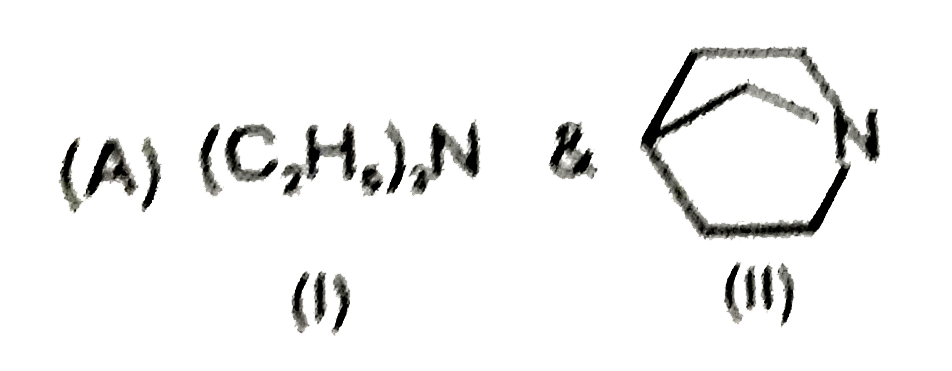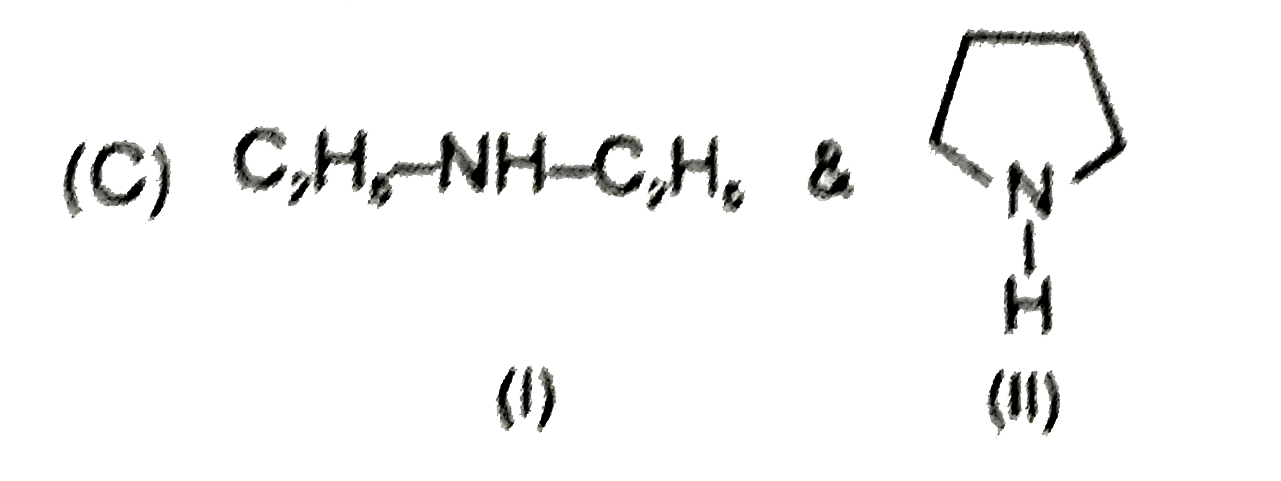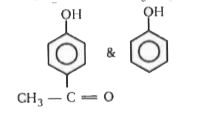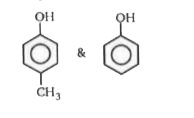In which compounds (II) is more basic than (I)

H2N−O∣∣C−NH2(I)&H2N−NH∣∣C−NH2(II)

CH3NH2(I)&(CH3)2NH(II)
The correct Answer is:A, B, C, D
To determine in which compounds (II) is more basic than (I), we need to analyze the structures and the factors affecting the basicity of the compounds. Basicity is influenced by the availability of the lone pair of electrons on the nitrogen atom, which can be affected by electron-donating or electron-withdrawing groups attached to it.
1. Identify the Compounds:
- Let's denote compound (I) as Compound 1 and compound (II) as Compound 2.
- For example, let’s consider the following pairs:
- (I) Diethylamine (C2H5)2NH
- (II) N,N-Diethylamine (C2H5)2N
2. Analyze the Electron-Donating Effects:
- In Compound 1, the ethyl groups (C2H5) are electron-donating through the +I (inductive) effect. This increases the electron density on the nitrogen atom, making it more basic.
- In Compound 2, the same ethyl groups are present, and they also provide a +I effect.
3. Consider Steric Hindrance:
- In Compound 1, the nitrogen atom is less sterically hindered compared to Compound 2. This means that the lone pair of electrons on nitrogen can be more available for bonding with protons (H+).
- In Compound 2, the presence of two ethyl groups increases steric hindrance, which can make the lone pair less available.
4. Evaluate the Conjugation Effects:
- For other pairs such as urea (Compound 1) and hydrazine (Compound 2), the nitrogen in hydrazine can participate in resonance, which stabilizes the molecule and increases basicity.
- In urea, the carbonyl group (C=O) withdraws electron density through resonance, making the nitrogen less basic.
5. Compare the Basicity:
- In the first pair, Compound 2 (N,N-Diethylamine) is more basic than Compound 1 (Diethylamine) due to the greater electron density provided by the ethyl groups, despite steric hindrance.
- In the second pair, Compound 2 (hydrazine) is more basic than Compound 1 (urea) due to the ability of nitrogen to donate its lone pair more readily without resonance stabilization.
- In the third pair, Compound 2 (pyridine) is more basic than Compound 1 (diethylamine) due to the availability of the lone pair on nitrogen.
- In the fourth pair, Compound 2 (dimethylamine) is more basic than Compound 1 (methylamine) due to the presence of two electron-donating methyl groups.
Conclusion:
In all the analyzed cases, Compound (II) is more basic than Compound (I).
- Let's denote compound (I) as Compound 1 and compound (II) as Compound 2.
- For example, let’s consider the following pairs:
- (I) Diethylamine (C2H5)2NH
- (II) N,N-Diethylamine (C2H5)2N
- In Compound 1, the ethyl groups (C2H5) are electron-donating through the +I (inductive) effect. This increases the electron density on the nitrogen atom, making it more basic.
- In Compound 2, the same ethyl groups are present, and they also provide a +I effect.
- In Compound 1, the nitrogen atom is less sterically hindered compared to Compound 2. This means that the lone pair of electrons on nitrogen can be more available for bonding with protons (H+).
- In Compound 2, the presence of two ethyl groups increases steric hindrance, which can make the lone pair less available.
- For other pairs such as urea (Compound 1) and hydrazine (Compound 2), the nitrogen in hydrazine can participate in resonance, which stabilizes the molecule and increases basicity.
- In urea, the carbonyl group (C=O) withdraws electron density through resonance, making the nitrogen less basic.
- In the first pair, Compound 2 (N,N-Diethylamine) is more basic than Compound 1 (Diethylamine) due to the greater electron density provided by the ethyl groups, despite steric hindrance.
- In the second pair, Compound 2 (hydrazine) is more basic than Compound 1 (urea) due to the ability of nitrogen to donate its lone pair more readily without resonance stabilization.
- In the third pair, Compound 2 (pyridine) is more basic than Compound 1 (diethylamine) due to the availability of the lone pair on nitrogen.
- In the fourth pair, Compound 2 (dimethylamine) is more basic than Compound 1 (methylamine) due to the presence of two electron-donating methyl groups.
In all the analyzed cases, Compound (II) is more basic than Compound (I).
Topper's Solved these Questions
- GENERAL ORGANIC CHEMISTRY IIBOOK - RESONANCE ENGLISHCHAPTER - GENERAL ORGANIC CHEMISTRY IIEXERCISE - Part-III: Section-4 : Comprehension Type
3 Videos
- GENERAL ORGANIC CHEMISTRY IIBOOK - RESONANCE ENGLISHCHAPTER - GENERAL ORGANIC CHEMISTRY IIEXERCISE - Part-III: Section-5: Matching List Type
1 Videos
- GENERAL ORGANIC CHEMISTRY IIBOOK - RESONANCE ENGLISHCHAPTER - GENERAL ORGANIC CHEMISTRY IIEXERCISE - Part-II: NSEC (Stage-I)
45 Videos
- GASEOUS STATEBOOK - RESONANCE ENGLISHCHAPTER - GASEOUS STATEEXERCISE - ORGANIC CHEMISTRY(Hydrocarbon)
18 Videos
- GENERAL ORGANIC CHEMISTRY-IBOOK - RESONANCE ENGLISHCHAPTER - GENERAL ORGANIC CHEMISTRY-IEXERCISE - PART-III : PRACTICE TEST-19
1 Videos
Similar Questions
Knowledge Check
Which of the followingg compounds are more basic than
 ACH3−CH2−..NH2BCH3−NH∣∣C−NH2C
ACH3−CH2−..NH2BCH3−NH∣∣C−NH2C DCH2=CH−..NH2
DCH2=CH−..NH2Among the given pairs, in which pair second compound is more acidic than first ?
ABrCH2NO2andCH3CH3BCH3−O∣∣CCH2CNandCH3−O∣∣C−CH3C D
D
Which of the following compounds are more acidic than H2O?
ACH3−OHBH−O∣∣C−OHCCH3−..NH2D
Which N of guanidine (I) is more basic and is more likely to be protonated ?
View SolutionThe structure of saccharin is given as follows:

How many following compounds are more basic than saccharin?
 .
.
View SolutionWhy Ce(OH)3 is more basic than Lu(OH)3 ?
View SolutionWhy Ce(OH)3 is more basic than Lu(OH)3 ?
View Solutionwhich compound produces more than twice the amount of ernergy as compared to carbohydrates ?
View Solution
